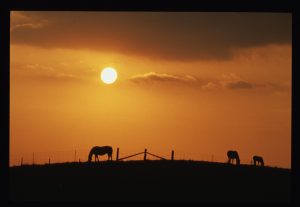Monday
Arts and PoetryHeaven, Earth, and Man
Heaven, Earth, and Man
In Contemplative Landscape Photography
John McQuade, 2021
“Heaven, earth and man can be seen literally as the sky above, the earth below, and human beings standing or sitting between the two…if we apply the perspective of heaven, earth and man to the situation in the world today, we begin to see that there is a connection between the social and the natural, or environmental.”
–Chogyam Trungpa, Sacred Path of the Warrior
The principles of Heaven, Earth and Man can be discerned in the manifestations of many ancient cultures and wisdom traditions: some Native American practices, the Shinto religion of Japan, the Tibetan spiritual lineages and the Chinese Taoist teachings. In general these principles provide for our natural place and conduct on this earth. This vision articulates an ancient and primordial deep ecology, which, speaking to us in our time of need, remains a most up to date teaching. Here we retain the traditional reference to Man noting that it references a primordial relationship of humankind rather than a gender specific designation.
As a principle, heaven represents vastness and sacredness: the source of vision and inspiration. Earth embodies the principle of support and receptivity. The element of earth is both practical and fecund: it grounds and promotes life. As an element heaven is the source of rain and shine, night and day and the other conditions that foster the fruition of the earth principle. The elemental union of heaven and earth manifest as the cycle of the seasons. Symbolically heaven is the source of blessings: the enrichment of the earth and mankind. When the elemental and symbolic relationship between heaven and earth is auspicious – when the rain is a blessing – then the earth yields and can be cultivated. Mankind is the medium of that cultivation. The authentic culture of man articulates the resources of energy and intelligence as an appropriate response to the dominion of heaven and earth. It is said that when human culture is in accord with the principles of heaven and earth then the four seasons and the other elements also will work together in harmony. This is the deep spiritual ecology. According to these teachings, mankind can overcome fear and strife and celebrate our destiny by finding our place in the primordial order of heaven and earth.
Landscapes are a traditional subject matter for photography and can be approached in many ways: for their scenic values, as travelogue, the naturalist interest in flora and fauna, the conservationist concern for the pristine beauty of wilderness and the honoring of scared sites. Contemplative photography divines the spiritual value and power of the land. It endeavors to find ways to express that sacred outlook.
Many contemplative arts such as Ikebana (flower arrangement) and Chinese landscape paintings embody the principles of heaven, earth and man as the heart and form of their discipline. Contemplative photography brings these principles to bear in the appreciation of landscapes. In general contemplative photography is a discipline of seeing that enhances the synchronization of eye and mind. When eye, mind, and world are in the same place at the same time, one sees clearly. Then the moment by moment vividness of the visual world becomes apparent and is appreciated fully. From this primacy of perception, contemplative photography approaches landscapes with the intent of discerning the relationship of heaven and earth.
We begin by noting landscapes in terms of a presentation of these principles as visual elements: heaven, earth and man can be seen simply as the sky above, the earth below and something as a joining function. Here one can discern the man principle in visual terms. The symbolic function of joining is not necessarily marked by a human being. It may be a tree, an animal, a fence, a hay round, a building and so forth. The visual world is gathered in terms of a formal visual presentation of these primordial principles. Other interests are set aside and extraneous visual elements are eliminated or minimized. This intent and craft solicits a certain perception and visual aesthetic characterized by simplicity, purity and space. With this basic and simple relationship of visual forms one discovers the essence of the contemplative vision: the contemplative forms are intrinsically symbolic. Like the forms of Ikebana, this visual landscape arrangement is an icon presenting a sort of deep structure or symbolic articulation of our place in the world.
The perception of this landscape form invokes a deep resonance that is more often felt than expressed in so many words. This is the heart of the contemplative view. It is the experience of resonance that informs the vision of the contemplative photographer. For example a lone tree standing at the horizon between the earth and the sky presents more than a visual object. It embodies a certain sensibility: perhaps loneliness and poignancy: perhaps simplicity and silence; perhaps dignity and strength – perhaps something that cannot be said in so many words.

This symbolism and sensibility can reflect through many dimensions of presence. In a more historical mode, one might wonder how it is that this tree comes to stand there. This lone tree not only symbolically stands for the man principle, it literally stands because of man: it alone was left standing when the forest was cleared for cultivation or pasture. One can say this was pragmatic: this shade tree provides respite from the heat for the animals and a place of repose for the men and women working the fields. Yet this practical concern does not contradict the principled connection of heaven, earth and man. On the contrary this practical human interest – the shade tree – embodies essential qualities of that relationship: simplicity, harmony and appreciation.
This practical consideration also bears a natural aesthetic: the simplicity of the tree and the expanse of the fields complement one another like a jewel in its setting. These formal elements articulate an everyday aesthetic sustaining a contemplative vision of the tree and the fields as they manifest through the light of the day and the turning of the seasons. Like Monet’s motifs the lone tree serves as a cipher registering the flow of the phenomenal world and the play of heaven, man and earth through the daily life of the seasons. The look of the land – what meets the photographer’s eye – the colors, the textures, the natural design of forms: these are the immediate and surface phenomena of the detailed and deep relationship of heaven, earth and man. The fields are a visual manifestation of their combined activity through the cycles of the seasons. The black of freshly plowed fields, the water in ruts reflecting the colors of the sky, the many greens of Spring and Summer, the yellows and gold’s of ripening grains, the shine of field stubble, the random patterns of hay stokes, winter’s white magic, the ways of the weather, the cycles of the sun, moon and seasons…all this and infinitely more in an endless and intricate display: the permutations of heaven, earth and man in landscape photography.
 One can give prominence to the Man principle, noting how it works with the land: the practical effect of a snow fence – the formation of snow drifts – is simultaneously a pleasing aesthetic image; the trace of roadways and pathways – an image that resonates with man’s passage through this span of life and the ways of the Dharma. Certainly these images and reflections bear the mark of my own experience in particular landscapes. This is a feature of the contemplative way: the relationship is always intimate and often local. The point is to discern in the particular landscape the relationship of heaven earth and man and thereby recall our true homeland.
One can give prominence to the Man principle, noting how it works with the land: the practical effect of a snow fence – the formation of snow drifts – is simultaneously a pleasing aesthetic image; the trace of roadways and pathways – an image that resonates with man’s passage through this span of life and the ways of the Dharma. Certainly these images and reflections bear the mark of my own experience in particular landscapes. This is a feature of the contemplative way: the relationship is always intimate and often local. The point is to discern in the particular landscape the relationship of heaven earth and man and thereby recall our true homeland.
Contemplative photography is not the only access to this view – it provides a sustained focus or skillful means. Since these principles are primordial and universal they can be seen to inform the vision of good landscape photography. The joy and beauty of landscape photography displays a tacit recognition of a fundamental harmony and appreciation. Season in and season out, it is this heartfelt connection with the power and beauty of landscapes that continues to solicit the photographer – the deep and abiding connection of heaven, earth and man.
 John McQuade is the founder of Nalanda Miksang Photography (www.miksang.org) and co-author of two books: Looking and Seeing, and Heart of Photography. He is a Shambhala Training teacher.
John McQuade is the founder of Nalanda Miksang Photography (www.miksang.org) and co-author of two books: Looking and Seeing, and Heart of Photography. He is a Shambhala Training teacher.
This contemplation was first written to honor of the enthronement of Sakyong Mipham Rinpoche as Earth Protector. Since then there has been an ongoing contemplation of the intimate relationship of the contemplative arts with deep spiritual ecology.
This Summer and Autumn there is a presentation of a program that engages this deep spiritual ecology through the contemplative practices of photography and haiku: Ways of Seeing and the Way of Nature.
An online Zoom format presented through Dorje Denma Ling July 10- August 19. (consult: dorjedenmaling.org) . An in-situ person to person format presented through Shambhala Mountain Center Sept 29- Oct 3. (consult: Shambhalamountain.org)





